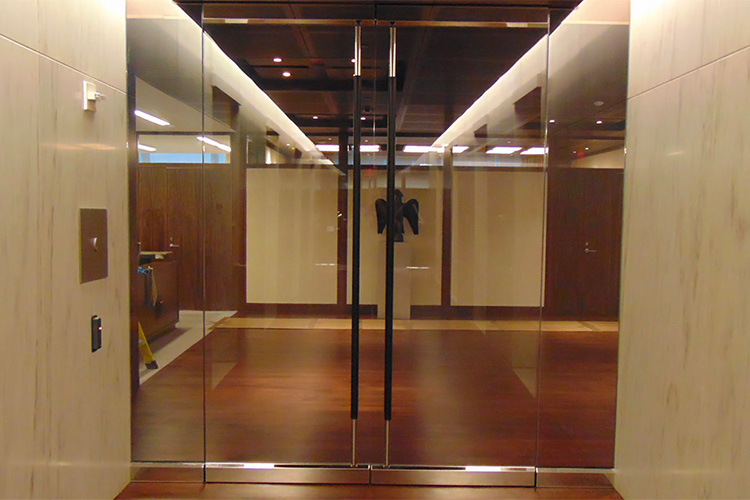Glass door security options: developing an all-glass bulletproof door
February 15, 2021
“Frameless” all-glass doors are broad and inviting—practically the standard for modern offices. It’s important to know, however, that startlingly few glass door security options both fit and meet aesthetic demands while still providing significant safety.
In fact, it wasn’t until the last few years that frameless all-glass ballistic security doors were available on the market. Until 2017, ballistic and security doors were largely limited to steel and wood-veneer with the occasional acrylic window. Some manufacturers produced doors with larger clear panels but they still required wide aluminum frames, which resulted in these options appearing “visually heavy.” A clean, broad, inviting “frameless” office door that could effectively stop bullets simply didn’t exist – yet.
“We really wanted to be able to offer that,” explains Total Security Solutions CEO Jim Richards. “An all-glass ballistic door: top and bottom rails with pivots and a pull, all glass, all polished. First, it just looks really great in a corporate setting. But also, we wanted to be able to offer something that was more secure—that could stop more and bigger bullets, that could carry a blast rating—but preserve that open, modern look.”
But there’s a very good reason that before Jim set his mind to it, there had never been an all-glass ballistic door on the market: “The evolution of the all-glass ballistic door,” Jim notes dryly, “That was painful.”
Download our checklist on 5 Things to Consider When Purchasing a Ballistic Door
Glass Door Alternative Security Options: Acrylic
“Acrylic is easy to work with,” Jim explains. “We’ve always done an acrylic door. An acrylic door is not an issue.”
Bullet-resistant acrylic glazing is a monolithic material. Manufacturers craft it from a single thick slab of thermoplastic. The thicker the slab, the stronger the window. “You can drill it, notch it, route it, bevel it, buff out scratches,” Jim says. “You can even do a lot of this fabrication or modification in the field if you need to. It’s great and very cost-effective.”
But it’s still plastic, with the attendant limitations. For example, due to how the material reacts to being cut and finished, it cannot be cleaned with many common “glass” cleaners (like Windex). Such cleaners cause hazing and crazing that makes the glass look awful.
Additionally, acrylic is a more brittle material and thus tends to spall (throw off chips) when struck or shot. These chips can injure people, even when the bullet itself doesn’t get through the window. Spalling also means that these windows can’t carry a blast or forced-entry rating.
Because acrylic is monolithic, the only way to increase its bullet-stopping power is to increase the thickness. As a result, acrylic-based bullet-resistant doors can only be rated to UL-Level 1 or 2 (that is, they are designed to stop shots from 9mm and .357 Magnum pistols).
And finally, acrylic is plastic. In most applications, it is going to look like plastic (albeit really nice, clear, polished plastic). “Like a bulletproof steel door, a bulletproof acrylic door is going to always look like a bulletproof door. That doesn’t fit everyone’s aesthetic needs. That’s why we wanted to make this all-glass door, and why we wanted to make it from GCP 1250, despite the challenges.”
Glass Door Security Options: GCP 1250
In contrast to monolithic acrylic, GCP (glass-clad polycarbonate) is composed of many layers. You can change the performance of the materials by changing the makeup (i.e. layering)—adding strength without adding thickness or introducing new characteristics. For example, with GCP the glass can have a frosted interlayer added to the makeup (for enhanced privacy), or a filtering layer to block out UV and infra-red light (so-called “Low-E” glass, which “reflects heat” while letting light pass through). You have options, like a colored tint or a mirrored layer, and the GCP is always low-spall or no-spall.
In the case of GCP 1250, the makeup has outer layers of quarter-inch tempered glass, and two inner layers of 3/8-inch polycarbonate, the same material used to make police riot shields. In the case of Level 3 GCP 1250, each polycarbonate layer is about twice as thick as a police shield. Even at this thickness, polycarbonate will flex and absorb a blow, rather than chip or break. This quality of polycarbonate that stops bullets is what lends doors their forced-entry resistance—at less thickness than acrylic with a lower ballistic rating.
The glass outer caps on GCP help with aesthetics (most casual observers and office visitors will not note the difference between GCP 1250 and standard glass) and protect the polycarbonate from dings, scratches, environmental stresses. and chemicals. In other words: No risk of a well-meaning, but careless, cleaner spritzing your doors with Windex and ruining the entryway aesthetic.
The Challenge of Working with GCP
Although GCP is thinner than comparable acrylic, it’s also heavier. A GCP office door is about 35% heavier than an acrylic door (which is already about 20% heavier than a standard glass office door).
In contrast to acrylic, GCP cannot be fabricated in a conventional shop (let alone drilled on-site). In order to create an all-glass ballistic door, TSS had to work closely with their glass manufacturer, who cut, drilled, and polished the GCP during the manufacturing process prior to shipping.
Because no one had ever made doors like these before, all sorts of tiny details and material challenges arose.
“Acrylic is forgiving,” Jim says. “GCP is much less forgiving and demands much higher attention to detail. For example, we had to learn the hard way—almost through trial and error—how closely the glass needed to be toleranced for the top and bottom rails, the exact spec for the edge polishing, the proper sizing for holes.”
Stress cracking around these holes proved to be a special challenge. Initially, it seemed like it was simply a matter of the holes not being sized properly. But after several rounds back and forth with the manufacturer, TSS determined that what they really needed was a slight alteration in how the outer glass layers are tempered.
Another issue was bowing in the GCP. Bowing is an artifact of the speed at which the GCP cooled during production. A certain amount of bowing is normal and acceptable— often even unnoticeable. But when meeting two pieces of glass (for example, at the opening of a double door) even very minor bowing in each is magnified by the juxtaposition. It becomes incredibly obvious.
The World’s First All-Glass Ballistic Office Doors
“We were fortunate to have a really close relationship with our glass supplier,” Jim notes. “Like any product we’ve grown or evolved, the first few attempts are always really painful. It takes a great deal of collaboration to bring in all of the people who have the specialized knowledge needed to make it work.” In the end, it took TSS 18 months (and roughly a dozen door installs) to hammer out every detail and get the all-glass ballistic door up to their expectations and high standards. The hard work paid off in the end; the result was a good looking, all-glass, level 3 ballistic door with a forced-entry rating. It can stand firm against shots from any pistol, burns from propane torches, blows from two-man door rams, and at least a full hour of being beaten with sledgehammers, pipes, hammers, and chisels. It’s the first of its kind- an aesthetically pleasing all-glass door that more than meets requirements for high safety standards.
“We’re wiser now, but it was really expensive wisdom,” Jim reflects. “It was worth it, though- it’s also a really good door.”
@TSSBulletProof #TSSBulletProof #bulletproof #healthcaresecurity #security #bulletproofglass
Company:  Total Security Solutions Inc
Total Security Solutions Inc
Tags:
Bullet Resistant
Doors
Glass
Glass Walls
The Daylighting Difference: Designing for Cold Climates (January 6, 2021), The Best of Both Worlds: Glass & Translucent Panels (August 4, 2020), Visual Blog: Kalwall in the Education Market (June 17, 2020), Glass house with load-bearing timber curtainwalls (October 25, 2019)


